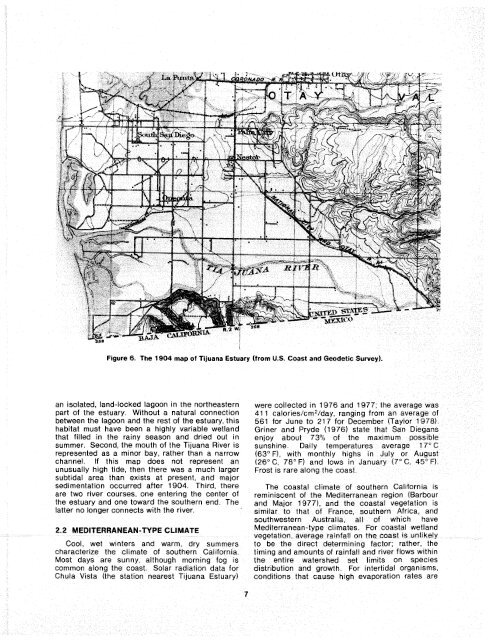The Ecology of Tijuana Estuary, California: An Estuarine Profile
The Ecology of Tijuana Estuary, California: An Estuarine Profile
The Ecology of Tijuana Estuary, California: An Estuarine Profile
Create successful ePaper yourself
Turn your PDF publications into a flip-book with our unique Google optimized e-Paper software.
Figure 6. <strong>The</strong> 1904 map <strong>of</strong> <strong>Tijuana</strong> <strong>Estuary</strong> (from U.S. Coast and Geodetic Survey).<br />
an isolated, land-locked lagoon in the northeastern were collected in 1976 and 1977; the average was<br />
part <strong>of</strong> the estuary. Without a natural connection 41 1 calories/cm2/day, ranging from an average <strong>of</strong><br />
between the lagoon and the rest <strong>of</strong> the estuary, this 561 for June to 217 for December (Taylor 1978).<br />
habitat must have been a highly variable wetland Griner and Pryde (1976) state that Sa'n Diegans<br />
that filled in the rainy season and dried out in enjoy about 73% <strong>of</strong> the maximum possible<br />
summer. Second, the mouth <strong>of</strong> the <strong>Tijuana</strong> River is sunshine. Daily temperatures average 17" C<br />
represented as a minor bay, rather than a narrow (63" F), with monthly highs in July or August<br />
channel. If this map does not represent an (26OC, 78" F) and lows in January (7OC, 45OF).<br />
unusually high tide, then there was a much larger Frost is rare along the coast.<br />
subtidal area than exists at present, and major<br />
sedimentation occurred after 1904. Third, there <strong>The</strong> coastal climate <strong>of</strong> southern <strong>California</strong> is<br />
are two river courses, one entering the center <strong>of</strong><br />
the estuary and one toward the southern end. <strong>The</strong><br />
reminiscent <strong>of</strong> the Mediterranean region (Barbour<br />
and Major 1977), and the coastal vegetation is<br />
latter no longer connects with the river.<br />
similar to that <strong>of</strong> France, southern Africa, and<br />
southwestern Australia, all <strong>of</strong> which have<br />
2.2 MEDITERRANEAN-TYPE CLIMATE Mediterranean-type climates. For coastal wetland<br />
vegetation, average rainfall on the coast is unlikely<br />
Cool, wet winters and warm, dry summers to be the d~rect determining factor; rather, the<br />
characterize the climate <strong>of</strong> southern <strong>California</strong>. timing and amounts <strong>of</strong> rainfall and river flows within<br />
Most days are sunny, although morning fog is the entire watershed set limits on species<br />
common along the coast. Solar radiation data for distribution and growth. For intertidal organisms,<br />
Chuia Vista (the station nearest <strong>Tijuana</strong> <strong>Estuary</strong>) conditions that cause high evaporation rates are<br />
7

















